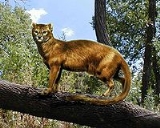
Proailurus
Encyclopedia
Proailurus was a prehistoric carnivore
that lived in Europe and Asia approximately 25 million years ago in the Late Oligocene
and Miocene
. One recent phylogeny places it as a basal member of the Feloidea, the superfamily that includes mongooses, civets, hyenas, and cats
; but other studies suggest that it instead was a felid
(a true cat).
Proailurus was a compact and small animal, just a little larger than the domestic cat, weighing about 20 lb (9 kg). It had a long tail, large eyes and sharp claws and teeth, with similar proportions to the modern viverrids. Its claws would have been retractable to some extent. Like the viverrids, Proailurnus was at least partially arboreal.
Proailurus, a likely ancestor of Pseudaelurus
which lived 20-10 million years ago, probably gave rise to the major felid lines, including the extinct machairodontines
and the extant felines
and pantherines
, although the phylogeny of the cats is still not precisely known.
Carnivore
A carnivore meaning 'meat eater' is an organism that derives its energy and nutrient requirements from a diet consisting mainly or exclusively of animal tissue, whether through predation or scavenging...
that lived in Europe and Asia approximately 25 million years ago in the Late Oligocene
Oligocene
The Oligocene is a geologic epoch of the Paleogene Period and extends from about 34 million to 23 million years before the present . As with other older geologic periods, the rock beds that define the period are well identified but the exact dates of the start and end of the period are slightly...
and Miocene
Miocene
The Miocene is a geological epoch of the Neogene Period and extends from about . The Miocene was named by Sir Charles Lyell. Its name comes from the Greek words and and means "less recent" because it has 18% fewer modern sea invertebrates than the Pliocene. The Miocene follows the Oligocene...
. One recent phylogeny places it as a basal member of the Feloidea, the superfamily that includes mongooses, civets, hyenas, and cats
Felidae
Felidae is the biological family of the cats; a member of this family is called a felid. Felids are the strictest carnivores of the thirteen terrestrial families in the order Carnivora, although the three families of marine mammals comprising the superfamily pinnipedia are as carnivorous as the...
; but other studies suggest that it instead was a felid
Felidae
Felidae is the biological family of the cats; a member of this family is called a felid. Felids are the strictest carnivores of the thirteen terrestrial families in the order Carnivora, although the three families of marine mammals comprising the superfamily pinnipedia are as carnivorous as the...
(a true cat).
Proailurus was a compact and small animal, just a little larger than the domestic cat, weighing about 20 lb (9 kg). It had a long tail, large eyes and sharp claws and teeth, with similar proportions to the modern viverrids. Its claws would have been retractable to some extent. Like the viverrids, Proailurnus was at least partially arboreal.
Proailurus, a likely ancestor of Pseudaelurus
Pseudaelurus
Pseudaelurus is a prehistoric cat that lived in Europe, Asia and North America in the Miocene approximately 20-8 million years ago. It is an ancestor of today's felines and pantherines as well as the extinct machairodont saber-tooths, and is a successor to Proailurus...
which lived 20-10 million years ago, probably gave rise to the major felid lines, including the extinct machairodontines
Machairodontinae
Machairodontinae is an extinct carnivoran mammal subfamily of Felidae endemic to Asia, Africa, North America, South America, and Europe from the Miocene to Pleistocene living from c. 23 Ma until c...
and the extant felines
Felinae
Felinae is a subfamily of the family Felidae which includes the genera and species listed below. Most are small to medium-sized cats, although the group does include some larger animals, such as the Cougar and Cheetah....
and pantherines
Pantherinae
Pantherinae is the subfamily of the family Felidae, which includes the genera Panthera, Uncia and Neofelis.The divergence of Pantherinae from Felinae has been ranked between six and ten million years ago. DNA analysis suggests that the snow leopard Uncia uncia is basal to the entire Pantherinae and...
, although the phylogeny of the cats is still not precisely known.

